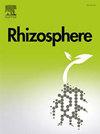温度和寄主植物生态型对毛杨固氮作用有影响,但对根瘤菌群落组成没有影响
IF 3.4
3区 生物学
Q1 PLANT SCIENCES
引用次数: 0
摘要
毛豆(Vicia villosa Roth)是一种在美国广泛种植的覆盖作物,它可以通过与豆科根瘤菌(Rhizobium leguminosarum biovar viciae, Rlv)细菌的生物固氮(BNF)为后续的经济作物提供氮。毛豆是美国中西部少数耐寒的覆盖作物之一。然而,不同地区毛豆对氮的贡献不同,可能是由于寒冷对豆科植物/根瘤菌共生的影响。改善豆科植物BNF的传统途径包括选择优良的根瘤菌菌株,以创造更有效的接种剂用于种植,但接种剂往往无法在农业土壤中竞争和生存。因此,本研究通过研究温度和寄主植物生态型对毛缕野豌豆根瘤中BNF和Rlv群落组成的影响,以期找到能够从土壤群落中选择有益Rlv菌株的毛缕野豌豆生态型。在温暖或寒冷的温度下,四种毛豌豆生态型从明尼苏达州的三种土壤中捕获了Rlv。在冷暖条件下,野豌豆的生态类型是BNF和根瘤形成的关键驱动因素。温度和植物生态型对结核中Rlv群落组成没有影响,对植物生产力没有影响。综上所述,这些结果表明,改善毛羊豌豆低温BNF的最佳策略可能取决于提高寄主植物生物量积累和固氮的育种,而不是专注于有益根瘤菌的寄主植物选择。本文章由计算机程序翻译,如有差异,请以英文原文为准。
Temperature and host plant ecotype drive nitrogen fixation, but not nodule rhizobia community composition, in hairy vetch
Hairy vetch (Vicia villosa Roth) is a commonly grown cover crop throughout the U.S., which can contribute nitrogen for subsequent cash crops through biological nitrogen fixation (BNF) in association with Rhizobium leguminosarum biovar viciae (Rlv) bacteria. Hairy vetch is one of the few cover crops sufficiently cold-tolerant to over-winter in the Upper Midwestern U.S. However, nitrogen contributions by hairy vetch vary across locations, potentially due to cold impacts on the legume/rhizobia symbiosis. The traditional route to improve BNF in legumes involves selecting superior rhizobia strains to create more effective inoculants to apply at planting, but inoculants often fail to compete and survive in agricultural soils. Instead, this study tested the effects of temperature and host plant ecotype on hairy vetch BNF and Rlv community composition in nodules, with the goal of potentially identifying vetch ecotypes able to select beneficial Rlv strains from the soil community. Four hairy vetch ecotypes trapped Rlv from three Minnesota soils, at warm or cold temperatures. Vetch ecotype was a key driver of BNF and nodule formation under warm and cold conditions. However, temperature and plant ecotype did not drive Rlv community composition in nodules, and Rlv community composition did not affect plant productivity. Taken together, these results suggest that the best strategy to improve BNF at low temperatures in hairy vetch likely depends on breeding for improved biomass accumulation and nitrogen fixation in host plants, rather than focusing on host plant selection of beneficial rhizobia.
求助全文
通过发布文献求助,成功后即可免费获取论文全文。
去求助
来源期刊

Rhizosphere
Agricultural and Biological Sciences-Agronomy and Crop Science
CiteScore
5.70
自引率
8.10%
发文量
155
审稿时长
29 days
期刊介绍:
Rhizosphere aims to advance the frontier of our understanding of plant-soil interactions. Rhizosphere is a multidisciplinary journal that publishes research on the interactions between plant roots, soil organisms, nutrients, and water. Except carbon fixation by photosynthesis, plants obtain all other elements primarily from soil through roots.
We are beginning to understand how communications at the rhizosphere, with soil organisms and other plant species, affect root exudates and nutrient uptake. This rapidly evolving subject utilizes molecular biology and genomic tools, food web or community structure manipulations, high performance liquid chromatography, isotopic analysis, diverse spectroscopic analytics, tomography and other microscopy, complex statistical and modeling tools.
 求助内容:
求助内容: 应助结果提醒方式:
应助结果提醒方式:


